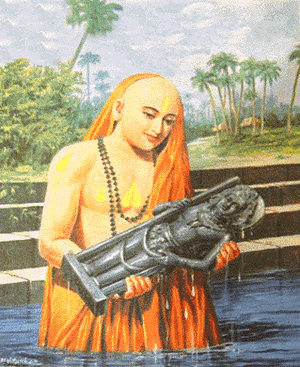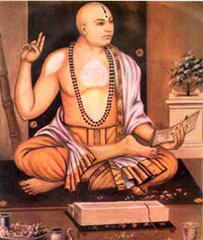
 Madhvacarya was born around 1238 A.D. eight miles south-east of the modern town of Udipi, in the Karnataka State. He is reputed to be the incarnation of Bhima, taking birth in Kali-yuga to destroy the daityas. Others refer to him as Vayu himself and it was his life's mission to defeat the followers of Sankaracarya.
Madhvacarya was born around 1238 A.D. eight miles south-east of the modern town of Udipi, in the Karnataka State. He is reputed to be the incarnation of Bhima, taking birth in Kali-yuga to destroy the daityas. Others refer to him as Vayu himself and it was his life's mission to defeat the followers of Sankaracarya.
He was born in the family of very elevated brahmanas and from his early childhood performed many amazing pastimes, such as the killing of a huge serpentine demon named Maniman, simply with the big toe of his left foot.
Madhava was only eight years old when he received spiritual initiation and at the age of twelve he accepted the sannyasa order and began to travel the length and breadth of India.
He enjoyed a long life of robust health. He engaged in various forms of sport and physical exercise in his youth, such as wrestling, swimming and even mountaineering, which he kept up to the very end. He had very handsome features with a strong muscular frame, tall and strong-limbed with graceful carriage and dignified bearing. Endowed with a magnetic personality and traditional thirty-two laksanas, he had a deep sonorous voice and good musical talent, which he used to advantage in Vedic recitation and in singing the soulful strains of his own devotional compositions and in giving open air discourses on the Bhagavata Purana, with its rolling melody of verses.
His life, as described in the Madhvavijaya, is the narrative of a born leader of men. Madhva recognized the soul of man to be potentially divine; but man, in the ignorance of his true status, has lost his soul to his body and its cravings, and needs to be awakened by God himself or His devotees.
He became a student under Acyutapreksa, who came in the order of Ekanti-Vaisnavas of the Ekadandi order. Madhva entered the sannyasa order and was given the name Purnaprajna.
During his study of the sastras he became convinced about the inherent weakness in the Advaita philosophy and developed a keen desire to revive the theistic science of Vedas with his own thorough reinterpretation of the texts.
After only a short time in his studies, frequent disagreements of views arose between himself and his teacher. Acyutaprajna could see that Purnaprajna was destined to make history for himself and made him head of the Math. On that memorable occasion Purn aprajna was given another name "Anandatirtha" and later adopted the name Madhva.
Madhvacarya spent some time teaching and engaging outstanding scholars belonging to Buddhist, Jain and Advaita Sampradayas, in logical and philosophical discussions and vanquishing them in debates. He set out to propagate his teachings and travelled exte nsively throughout South India. He visited Kanyakumari, Ramesvaram and Srirangam holding discourses on the Brahmasutras and openly criticizing Sankaracarya's Bhasyas on the Sutras. Giving his own interpretations he soundly defeated all he encountered and naturally roused a good deal of opposition from the leaders of the old schools of thought. At Kanyakumari he met with stiff opposition from an Advaitic monk of great learning who challenged him to write a fresh commentary on the Brahmasutras before he ventured to criticize the time honored one of Sankaracarya. Madhva assured him that he would be doing so, in good time. At Srirangam he came in contact with the followers of the Ramanuja school and after exchanging views with them, noted his own points of agreement and difference with them. This South Indian tour gave him great resolve to set out on his first tour of the north.

Madhvacarya was anxious to go to Badarikasrama and receive personal inspiration from a visit to the asrama of Vyasadeva. After staying forty-eight days at Badarinath, fasting, praying, meditating and dedicating his Gita-Bhasya to the Lord, Madhvacarya was inspired to go to the hermitage of Vyasa. He went there all alone and after gaining the personal darshan of Vyasadeva himself and learning from him, returned after some months, glowing with divine inspiration and wrote his Bhasya on the Brahma-Sutras.
Journeying through Bihar, Bengal, Orissa, Andhrapradesa, Maharashtra and Karnataka, he returned to Udipi. On his way back from Badarikasrama, Madhvacarya challenged many eminent scholars of the day. Prominent among these were two outstanding scholars, Swami Sastrin and Sobhana Bhatta, known as masters of the six systems of philosophy. Madhvacarya soundly defeated these two who subsequently became his disciples known as Narahari Tirtha and Padmanabha Tirtha respectively.
Madhvacarya's fame and prestige had grown considerably and his commentaries on the Gita and Brahmasutras had made their mark and were widely recognized and respected. In his Math in Udipi he introduced strict codes of conduct for his followers, introduced the system of Pistapasuyagas (offerings made from flowers), in place of actual animal sacrifices in yajnas and imposed the rigorous observance of fasts on Ekadasi. To foster a sense of fellowship among his disciples he installed a beautiful deity of Lord Krsna.
"Once, as Madhva was traveling in the association of his disciples he arrived in Sri Navadwipa and decided to spend some days within the forests of Modradumadvipa.
One night, as Madhva lay sleeping, Lord Gauranga appeared to him in a dream. The Lord told Madhava, "It is well known to everyone that you are My eternal servitor. When I appear here in Navadwipa, I will accept your sampradaya. Travel everywhere and care fully uproot all the false scriptures of the mayavadis and reveal the glories of worshipping the personal form of the Supreme Personality of Godhead. Later, when I appear, I will personally broadcast your pure teachings." The Lord then disappeared.
When Madhva awoke, he was astonished and as he remembered the Lord he began to cry in separation, saying, "Will I ever see that beautiful golden form again?" A celestial voice from the sky replied, "Worship Me secretly and you will come to Me."
Carrying these instructions within his heart, Madhva continued his travels more determined than ever to defeat the mayavadi philosophers." (from Sri Navadwipa Dham).
During a meeting between King Jayasimha, the Ruler of Kumbla and Madhvacarya, a historic disputation developed with the Ruler's Court Pandit, Trivikrama Pandit, who was the foremost authority on Advaita-vedanta. Trivikrama engaged Madhvacarya in a vigorous debate for fifteen days, at the temple of Kudil and was defeated by the Acarya. He sought to become a disciple of Madhvacarya and was readily admitted. He was then commissioned to write a commentary on the Brahma-Sutra Bhasya, and named it Tattva-pradipa.
An interesting incident took place during his second trip to North India. With the country under tight control of the Persian invaders, traveling became very hazardous. With Madhvacarya's knowledge of Persian, his courage and tact in handling difficult situations and his ability to rise to equal occasions with dignity and complete self-possession, he was able to escape from potentially dangerous encounters. One such episode took place with his meeting with Sultan Jalal-uddin-Khilji. Political hostilities were on at the time. Madhvacarya and his party were forced to swim across the Ganges to the other side. They were halted on reaching the shore and were taken to the Ruler who called upon Madhva to explain his conduct in disobeying orders and crossing the river when hostilities were on. Madhvacarya spoke to the Ruler in his own language, convincing him on the importance of his mission in the cause of Theism.
After completing many commentaries and original erudite works, establishing prominant Maths and sending out well-chosen veterans to preach and propagate his siddhanta all over the country, while seated during a shower of flowers, Madhvacarya disappeared from vision and transferred himself to Badarikasrama. There he still remains.
Shri Madvacaharya taught that:
1.Krishna, who is known as Hari is the Supreme Lord, the Absolute.
2.That Supreme Lord may be known through the Vedas.
3.The material world is real.
4. The jivas, or souls, are different from the Supreme Lord.
5.The jivas are by nature servants of the Supreme Lord.
6.There are two categories of jivas: liberated and illusioned.
7.Liberation means attaining the lotus feet of Krishna and entering into an eternal relationship of service to Him.
8.Pure devotional service is the cause of this relationship.
9.The truth may be known through direct perception, inference, and Vedic authority.
![[Bhaktivedanta Memorial Library Logo]](../grfx/bml_logo.gif)